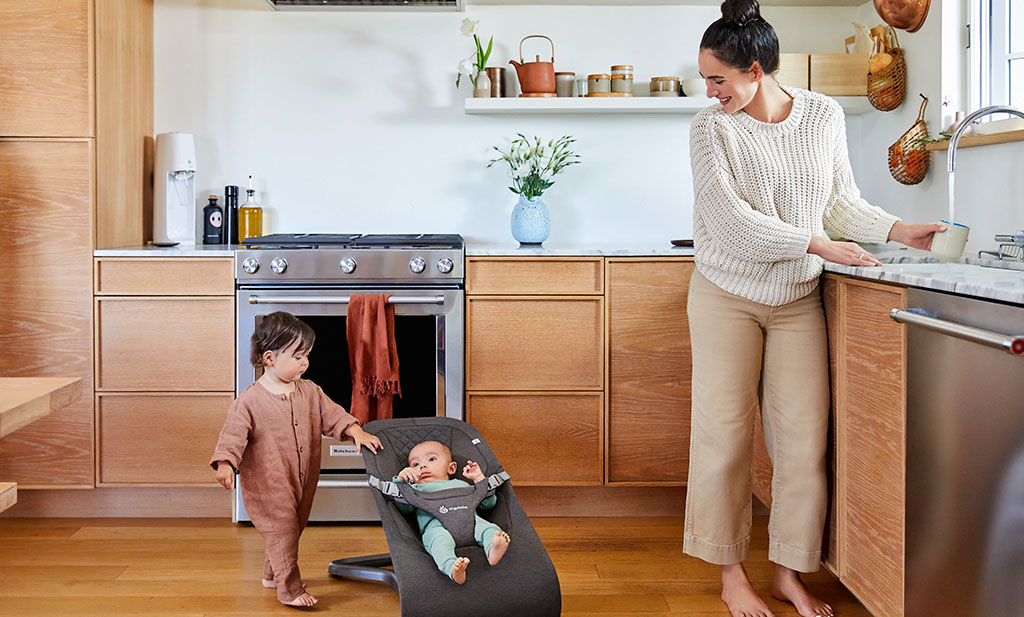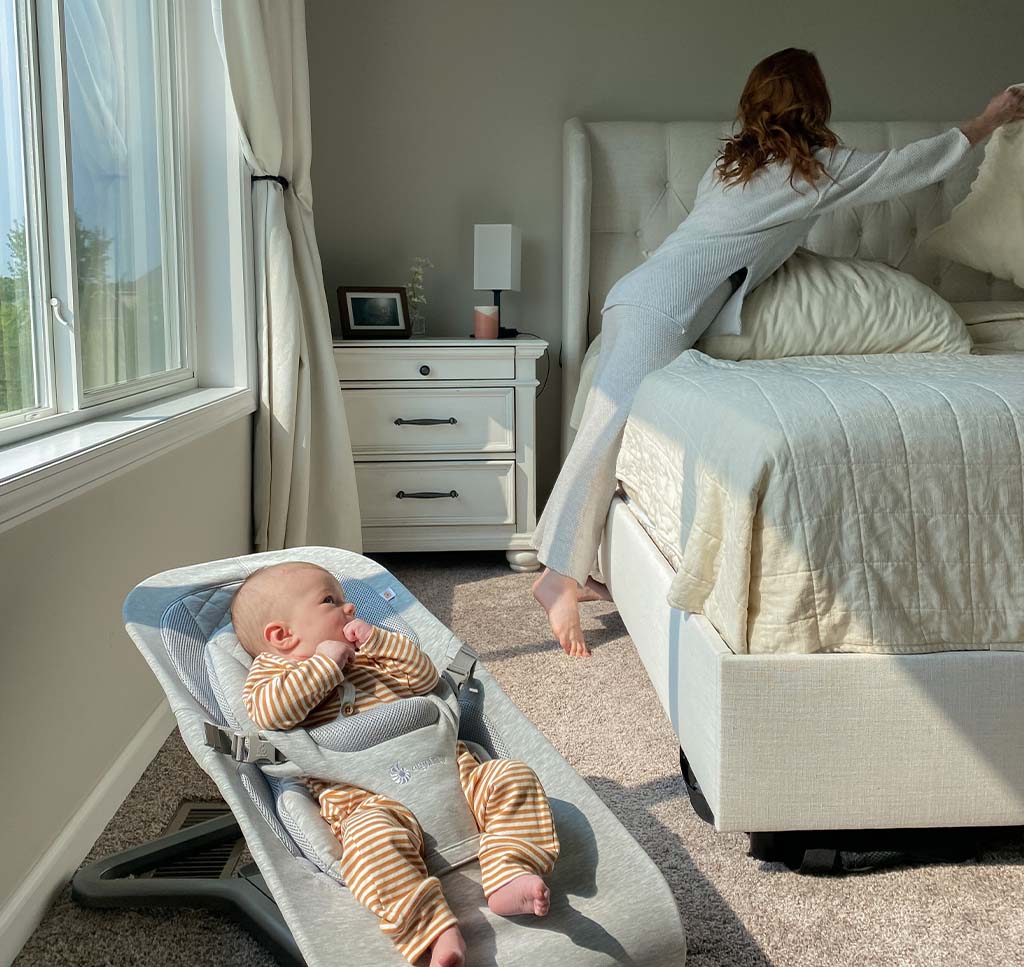
Obviously we’re big fans of babywearing and keeping baby close, especially in the fourth trimester. But we also know there are times when you need to put your baby down for a moment. To go to the loo. Shower. Do some postnatal exercise. Just take five minutes where you’re not being touched. Whatever it is, you might be asking “where can I put my baby (without them immediately protesting because they can’t be close to me)”? A baby swing seat or rocker, a car seat, baby bouncer, playpen, bassinet? There are a lot of options but we might be able to help. Together with our expert and midwife Katrin Ritter, we’ll explore different options today.
Baby Bouncer
There are various types of baby bouncers and baby swings available. Generally, most baby bouncers are portable, compact, and easy to carry around. They’re typically comfortable, user-friendly, and equipped with straps to keep your baby secure. When your little one is in the bouncer, depending on their age and the bouncer’s design, they can learn to create movement through their own actions, helping them self-regulate. However, for a baby bouncer to be truly ideal, it must be ergonomic (preferably from birth), grow with your baby, and allow a position similar to being carried in a baby carrier (supporting the spine and the legs in an ‘M’ position). It should also provide ample space for your baby’s head to turn and hold naturally. Importantly, try to avoid electric-powered options to prevent overstimulation.
Electric Baby Swing
An electric baby swing can quickly soothe a fussy baby. Brilliant! Perhaps they’ll even fall asleep? But wait! That’s not actually what we want.
The constant motion, back-and-forth movement, and motor noise might be sleep-inducing, but they’re also continuous external stimuli that can quickly overwhelm your baby. It’s better if your little one can decide when movement helps, based on their needs and situation. For instance, by powering the swing themselves.
Another drawback is that your baby might become ‘addicted’ to this type of movement. If they learn to regulate their emotions only through this external stimulus and can only fall asleep with constant rocking, you’ll need to provide exactly that, always and everywhere. Which is fine if you’re happy with that but otherwise can become tricky to maintain.
Moreover, swings like these are often poorly designed ergonomically. The swing’s surface doesn’t offer proper support, causing your baby to lie in a curved position. This can push your little one’s chin to their chest, potentially restricting breathing. It’s crucial to note that none of these devices are suitable or recommended for sleeping.
Newborn Seat for High Chair
Being at eye level with Mum and Dad during dinner… That sounds like something many babies would enjoy. And they do. In the kitchen, your baby can watch your every move while cooking, and you can keep an eye on them. However, ergonomics matter here too. These seats often lack proper ergonomic design, meaning they don’t support your baby’s body in a developmentally appropriate way. They also might not account for the size of your baby’s head, which needs space to turn.
Baby Hammock
While not a popular option, some people choose a baby hammock as it often seems to soothe a baby quickly or even rock them to sleep. You attach the baby hammock to a ceiling hook, doorframe, or a special stand and start the motor. The constant swinging does the rest, allowing you to perhaps carry on with your tasks without having to soothe your child yourself.
So far, so good, but: similar to the electric swing, there’s a lot to dislike from a professional perspective. For example, your baby lies very un-ergonomically with a rounded, slumped back in the fabric of the baby hammock. This often pushes their little head onto their chest, which can lead to difficulty breathing. And that’s not all. Their head is also forced to stay in the position you’ve placed it – because the space needed to turn their head, especially in the first months, isn’t available.
Moreover, the baby hammock can’t be adjusted to suit age and development. It also doesn’t promote self-regulation, as the movement impulses come from outside and your child can’t even see you. This means, as with the electric swing, that too many external stimuli affect your little one, which can simply overwhelm them and make them crave more. Yes, sometimes the little ones fall asleep with the constant rocking, but firstly, this contradicts the recommendations experts make to prevent Sudden Infant Death Syndrome (sleeping only on a firm and breathable mattress), and secondly, your little one usually wakes up very quickly, as they sense you’re not there and no one is co-regulating their needs.
Car Seat
A car seat seems like a practical option. You likely need one anyway so don’t have to buy anything new for your daily routine. It can be placed next to the shower, near you in the kitchen, or wherever you want your little one. They can keep an eye on you, and you can interact with them often. This strengthens your bond. However: A car seat is designed to ensure maximum safety during car rides, but at home, it greatly limits movement and often isn’t very ergonomic. For example, it only allows limited head movement, and often keeps baby in a cradled position which can again lead to “chin on chest” positioning which could negatively impact baby’s ability to breathe. So: short car trips yes, at home not so much. Best to leave it in the car; constantly lugging the seat around isn’t good for your back and pelvic floor health anyway.
Floor or Play Mat
Get your little ones on the floor! Yes, for playing and practising tummy time, that’s exactly where we want to see your precious ones. But for a tiny newborn, the play mat is simply too cold and unergonomic when they’re not being carried or sleeping – especially if you don’t want to sit right next to them. With their not-yet-straightened spine and forward-oriented hip joints, your little baby can’t lie stably on a flat surface. It’s a very uncomfortable position for them. As your little one grows older, they’ll naturally spend more time on the floor to further develop their motor skills through play.
Playpen
The playpen is somewhat more suitable, especially if you have pets – but really more for older babies to play or practise tummy time. For newborns, it’s likely as uncomfortable as the play mat, as no ergonomic position can be taken here either. And besides, it’s not flexible to take everywhere so you’re confined to one place.
Sofa
What else? As you look around, your eyes might land on the sofa. Who needs an extra baby accessory or piece of furniture when you’ve got something comfy, practical, and cosy right in front of you? Sadly, your favourite spot doesn’t make our top picks list. The sofa is simply too risky as a potential resting place for a baby. Your little one could fall off or roll face-first into a cushion or sofa crease, potentially suffocating in the worst case!
Cushions or Nests
A specially designed cushion, nest or “docking station” on the sofa offers a bit more safety. It contains your baby, is comfy, and can be taken anywhere. However, depending on its design, it can still pose some risks. There’s still a danger of suffocation and falls and they aren’t suitable for sleeping. And most nests (depending on their construction) aren’t really ergonomic either.

Baby Walkers and Jumpers
These are all an absolute no-no from a midwife’s perspective! Firstly, a baby walker or jumper is off-limits for newborns anyway, but even later, it doesn’t help your baby’s development at all and can even be harmful both from a developmental point of view and with the increased risk of accidents. They are even banned in some countries. So please, hands off!
Requirements for the Ideal Resting Spot
That’s a summary of the different options for placing baby down when you need to. And to recap, here’s an overview of what you should look for in your chosen spot for putting baby down:
- Ergonomic: Supports the spine, position like when carrying, ‘M’ position, and enough space for your baby to turn their head.
- Grows with baby: Not only does your baby’s body keep developing, but their needs can be completely different in just a week. So the resting spot should be adjustable accordingly.
- Safe and healthy: Your baby should be secured in their natural position so you don’t have to worry about falls or similar risks.
- Comfortable: Your little one will only feel content if it’s cosy and comfy.
- Supports Development: An ideal resting spot should offer ample space for growth and movement, whilst aiding in learning self-regulation.
- Not Overstimulating: Natural movements that your little one can initiate themselves are best. This also promotes self-regulation.
- Doesn’t Encourage Sleep: Your baby should only be gently soothed and supported, not doze off immediately. Sleeping isn’t recommended in any of these options.
- Promotes Bonding: Your baby can always see you to help them feel safe and secure, and you can interact with them – this strengthens your bond
- Flexible and Mobile: You should be able to take whatever you choose anywhere and be able to transport quickly and easily with one hand.
- Easy, Quick Handling: Whatever you choose should be quick and simple to set up or place, allowing you to respond well to your little one’s needs. Remember: You always need both hands to lay the baby down.
- Small and Compact: When not in use, it’s wonderful if it can be easily stored away.
Baby Bouncer, Baby Swing etc. – Our Recommendation
Ergonomic, adaptable, safe, comfortable, developmentally appropriate, promotes bonding, not overstimulating or sleep-inducing, flexible, small, compact and easy to handle – that’s our list of requirements for somewhere safe to pop your newborn. We know it’s long but for good reason. We only want the best for your little love. Our recommendation is an ergonomic baby bouncer, like our Evolve 3-in-1 Baby Bouncer. It ticks all the boxes on the checklist and we really believe it’s the best choice for most families and most situations.



